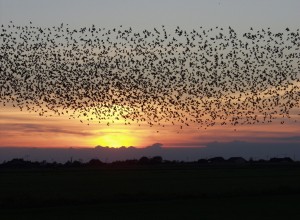
Bird Migration
Why Do Birds Migrate
Canada is home to millions of migrating birds that return to our lakes and forests every spring to nest, before returning south in the fall. Why do they make this long, hazardous annual journey?
 The simple answer is abundance of food, and the timing of the breeding cycle.
The simple answer is abundance of food, and the timing of the breeding cycle.
Present day migratory patterns have evolved over thousands of years of climatic change. Migrating birds use well established, food-rich paths along a north-south axis. The need to undertake this journey is now instinctive.
Birds return in early spring, often in miserable harsh weather. If birds waited until the food on their breeding range became abundant to begin the migration, they would not have time to migrate, mate and raise their young, taking advantage of the abundance of insects and other food species.
The timing of the cycle must result in the young having an abundance of food, as well as warmer weather, so they arrive early in the spring.
The reverse is also true for the fall migration. If they waited until the climate in the breeding range became intolerable, it would be too late to gain the necessary energy surplus requirements required to sustain a long migration.
How Do Birds Find Their Way?
Birds are thought to calculate the sun’s arc relative to the horizon, using its height and direction to obtain a north-south axis. Nocturnal migrants may use the stars to navigate. A known sensitivity to changes in barometric pressure enables them to avoid bad weather and exploit tail winds.
The ability to detect low frequency sound waves may help them hear things like breaking waves, while their own calls may be picked up as echos off mountains. Other factors such as the magnetic field of the earth, or the moon, may also be used.
While the facts of migration may elude us, the dangers of it do not.
• most songbirds migrate at night, when they may be struck by planes, autos or trains
• birds run into buildings, utility wires and high bridges
•cell phone towers, radio and TV towers, and the steel cables that support them kill an estimated one million birds each year
• wind turbine farms also take an enormous toll on migrating birds
• birds become disoriented by the dazzling lights of airports, lighthouses and floodlit buildings
It’s worth noting that these circumstances account for more deaths each year than all other causes of mortality combined – and they’re all man made.
Helping Birds Migrate
• You can start by evaluating your property. It is important to remember that a diversity of habitat encourages a larger variety of birds.
• Dead trees and brush piles provide shelter, nest sites and food (insects) for migrating birds.
• Providing water can be as simple as putting out a bird bath or as complicated as installing a pond with a creek and waterfall.
• Herbicides, fungicides and pesticides – can be lethal to birds.
• Put out bird feeders, seed, fruit and nectar feeders, and fruit.
• Landscape the yard with native evergreen and fruit bearing trees, shrubs, grasses and vines. Design the garden so that plants flower and fruit throughout the spring, summer and fall.
• Having a source of water (especially a moving source) can help attract more migratory birds.
• Getting involved in migratory bird conservation here in the United States or in Latin America can be as simple as writing a check, donating equipment or picking up a shovel.